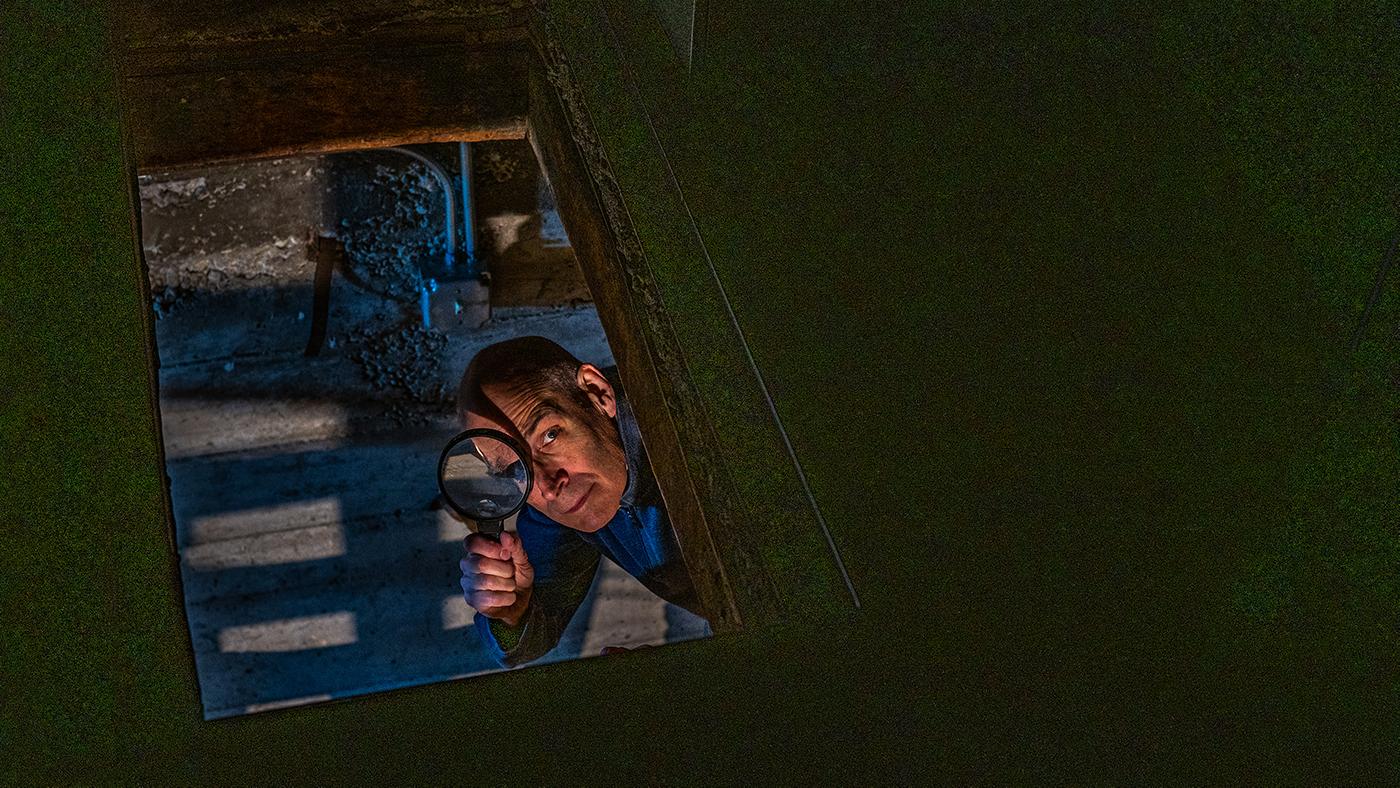The Eye-Grabbing Architecture of Chicago's College Campuses
Geoffrey Baer
March 3, 2023

I’ve had beauty on the brain lately as we approach the March 7th premiere of my newest WTTW program and companion website called The Most Beautiful Places in Chicago. If you’re in search of beautiful buildings yourself (or at least dramatic ones), the biggest bang for your buck is to explore Chicago-area college campuses. They virtually all have noteworthy structures within easy walking distance of each other. At the University of Chicago, for example, you can find work by Chicago architects Henry Ives Cobb, Dwight Perkins, Mies van der Rohe, Helmut Jahn, Jeanne Gang, and Carol Ross Barney, as well as by other big names such as Eero Saarinen, Rafael Viñoly, and Billie Tsien and Tod Williams, among many lauded others.
Here’s a tour of outstanding buildings at some of our institutions of higher learning, organized by school.
University of Chicago
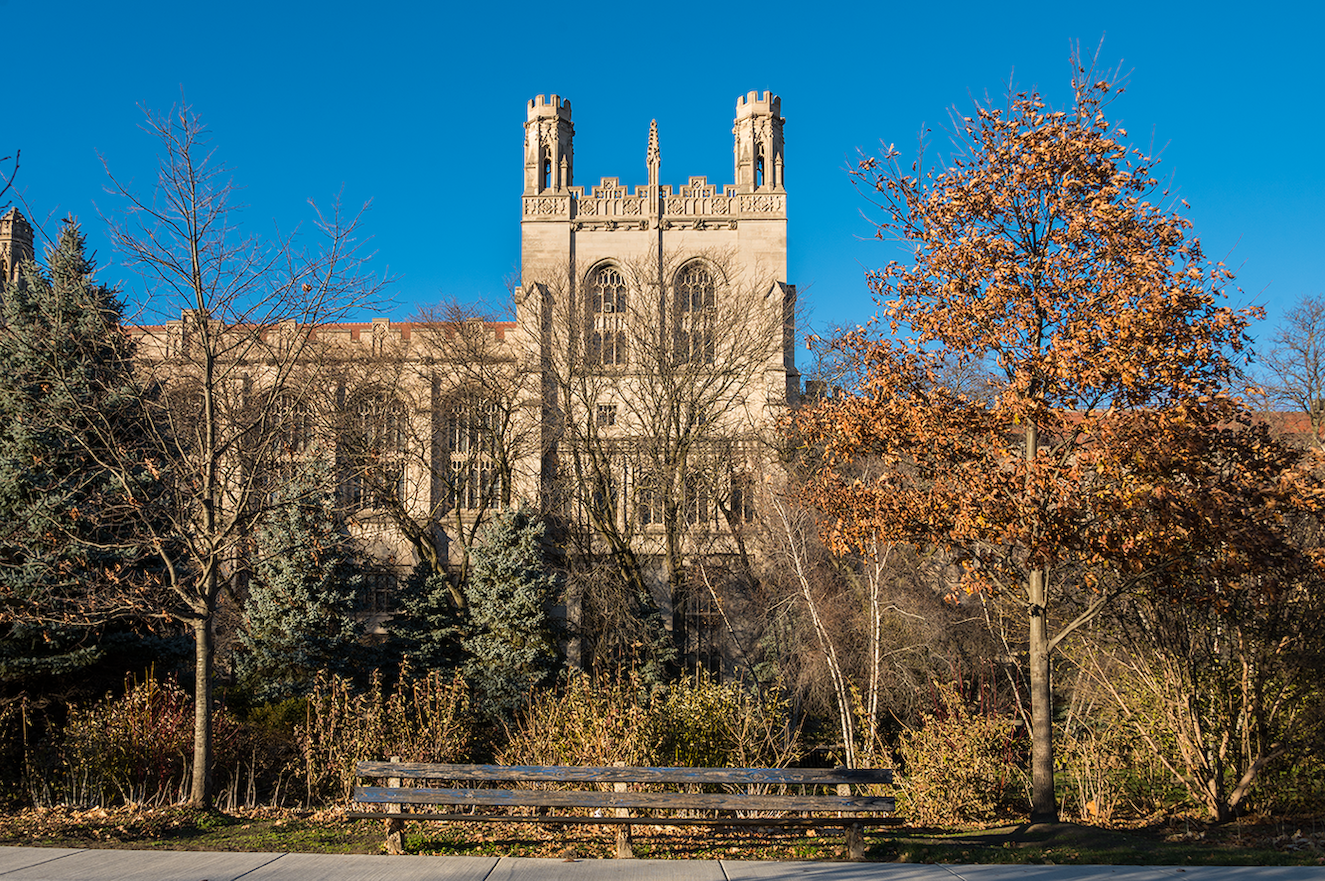 The University of Chicago has both quadrangles surrounded by Gothic architecture, such as the William Rainey Harper Memorial Library, and modern buildings by "star-chitects." Photo: WTTW/Ken Carl
The University of Chicago has both quadrangles surrounded by Gothic architecture, such as the William Rainey Harper Memorial Library, and modern buildings by "star-chitects." Photo: WTTW/Ken Carl
As you can tell from the notable architects listed above who have contributed to the University of Chicago’s campus, there’s simply too much here to point out, so I’ll just mention two sites. The storied Gothic quadrangles, planned in large part by Henry Ives Cobb, featured in When Harry Met Sally…—as well as in my The Most Beautiful Places in Chicago audio tour, which you can find at wttw.com/beautifulplaces after the show premieres on March 7.
Though not as well-known as the “star-chitects” who’ve contributed buildings to the UChicago campus, architect Ike Colburn is a personal favorite of mine. He was a consulting architect for the university from 1964 to 1973. His idiosyncratic vision is especially apparent on the Science Quadrangle bounded by Drexel and Ellis Avenues and 57th and 58th Streets. His Henry Hinds Laboratory for Geophysical Sciences is a playful castle with asymmetrical towers, mixing the Gothic architecture of much of the campus with the imposing concrete of mid-century Brutalism. The Cummings Life Science Center is one of the tallest buildings on campus and is walled with 40 brick air venting towers that mimic the crenellated ramparts of a medieval castle.
The Chicago Architecture Center offers walking tours of the campus in warmer weather if you want to explore it further.
Illinois Institute of Technology
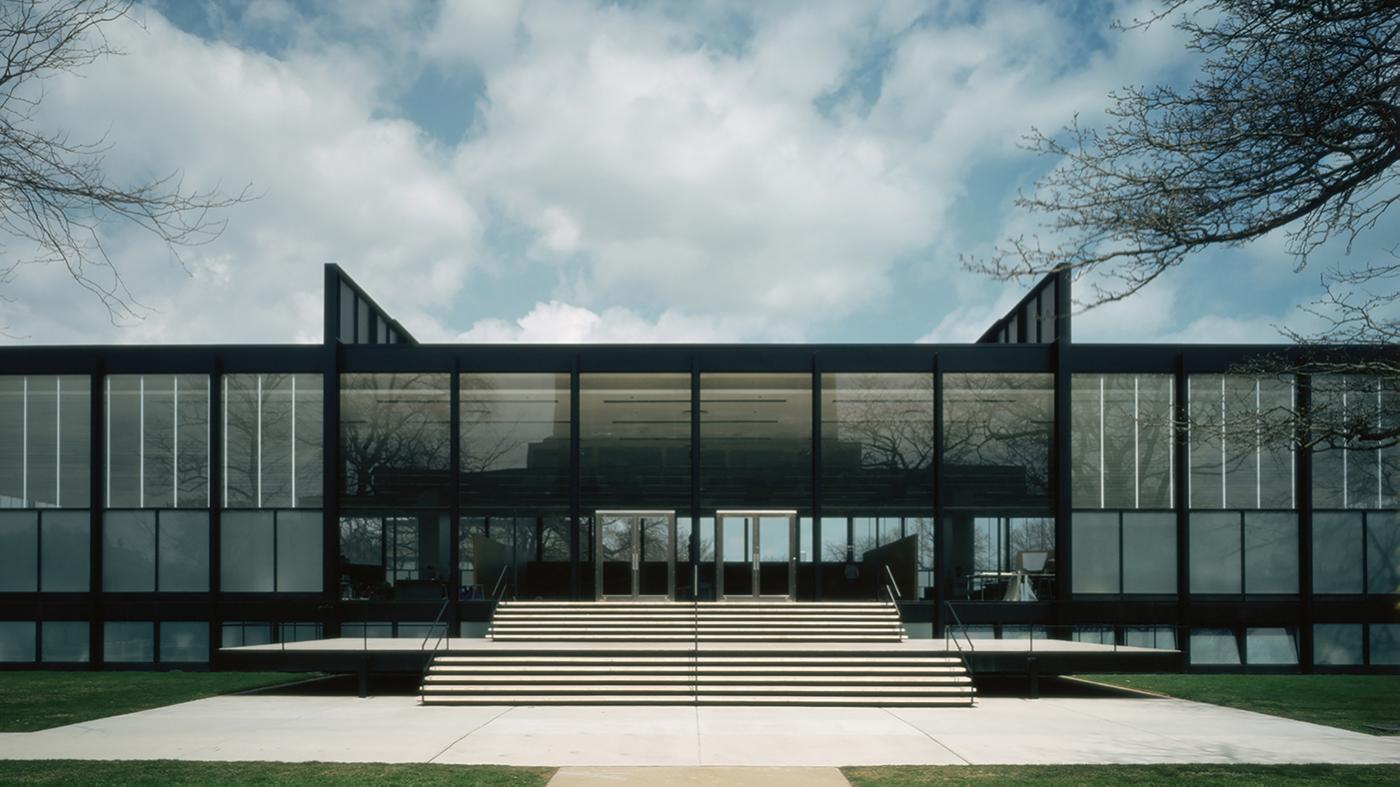 Mies van der Rohe designed the campus of IIT and contributed twenty-two of its buildings, including his masterpiece, Crown Hall. Photo: Courtesy Illinois Insitute of Technology
Mies van der Rohe designed the campus of IIT and contributed twenty-two of its buildings, including his masterpiece, Crown Hall. Photo: Courtesy Illinois Insitute of Technology
The Illinois Institute of Technology is famous for its architecture. The campus was designed by the influential mid-century German architect Mies van der Rohe, who immigrated to Chicago in 1938 to become director of the architecture department at what was then known as the Armour Institute. Twenty-two of the buildings on campus were designed by Mies, including his masterpiece, Crown Hall, which is included in my Beautiful Places audio tour.
While Mies’ vision allowed for a consistency throughout the campus, there are some more recent standouts that provide variety: Rem Koolhaas’ 2003 McCormick Tribune Campus Center, with its tube enclosing the ‘L;’ the innovatively green Kaplan Institute by John Ronan (a professor at IIT) featuring pillow-like inflatable walls; and dorms by the late, renowned architect Helmut Jahn, who studied at IIT.
City Colleges of Chicago
 Wilbur Wright College on the Northwest Side was the final commission of Bertrand Goldberg, the architect of Marina City. Photo: Zagalejo via Wikimedia Commons
Wilbur Wright College on the Northwest Side was the final commission of Bertrand Goldberg, the architect of Marina City. Photo: Zagalejo via Wikimedia Commons
If some City Colleges of Chicago strike you as bearing a resemblance to IIT, it’s because of the pioneering Black architect John Moutoussamy, who studied under Mies at IIT. Moutoussamy is best-known for the former Johnson Publishing Building in the South Loop, but he also designed modernist buildings for Harry S. Truman College, Olive-Harvey College, and Richard J. Daley College.
Wilbur Wright College on the Northwest Side departs from that template, having been designed by Bertrand Goldberg, who famously designed the corn-cob shaped towers of Marina City overlooking the Chicago River downtown. The college was Goldberg’s last commission, and includes a surprising pyramid-shaped building as well as some structures more characteristic of Goldberg’s better-known work, with curving concrete and cut-out windows.
Columbia College
 Columbia College has saved many old buildings of the South Loop, including the former Paramount Pictures Film Exchange, now Columbia's Dance Center. Photo: Beyond My Ken via Wikimedia Commons
Columbia College has saved many old buildings of the South Loop, including the former Paramount Pictures Film Exchange, now Columbia's Dance Center. Photo: Beyond My Ken via Wikimedia Commons
Columbia College has bought up several historic structures in the South Loop (including, at one point, the former Johnson Publishing Building) and renovated or remodeled them, including the Art Deco former Paramount Pictures Film Exchange at 1306 S. Michigan Avenue, which is now the college’s dance center. One contemporary addition is the transparent student center on Wabash Avenue, designed by Gensler and opened in 2019. Another is the Media Production Center on South State Street, designed by acclaimed Chicago architect Jeanne Gang, with windows that seem inspired by the color bars of a TV test pattern.
Roosevelt University
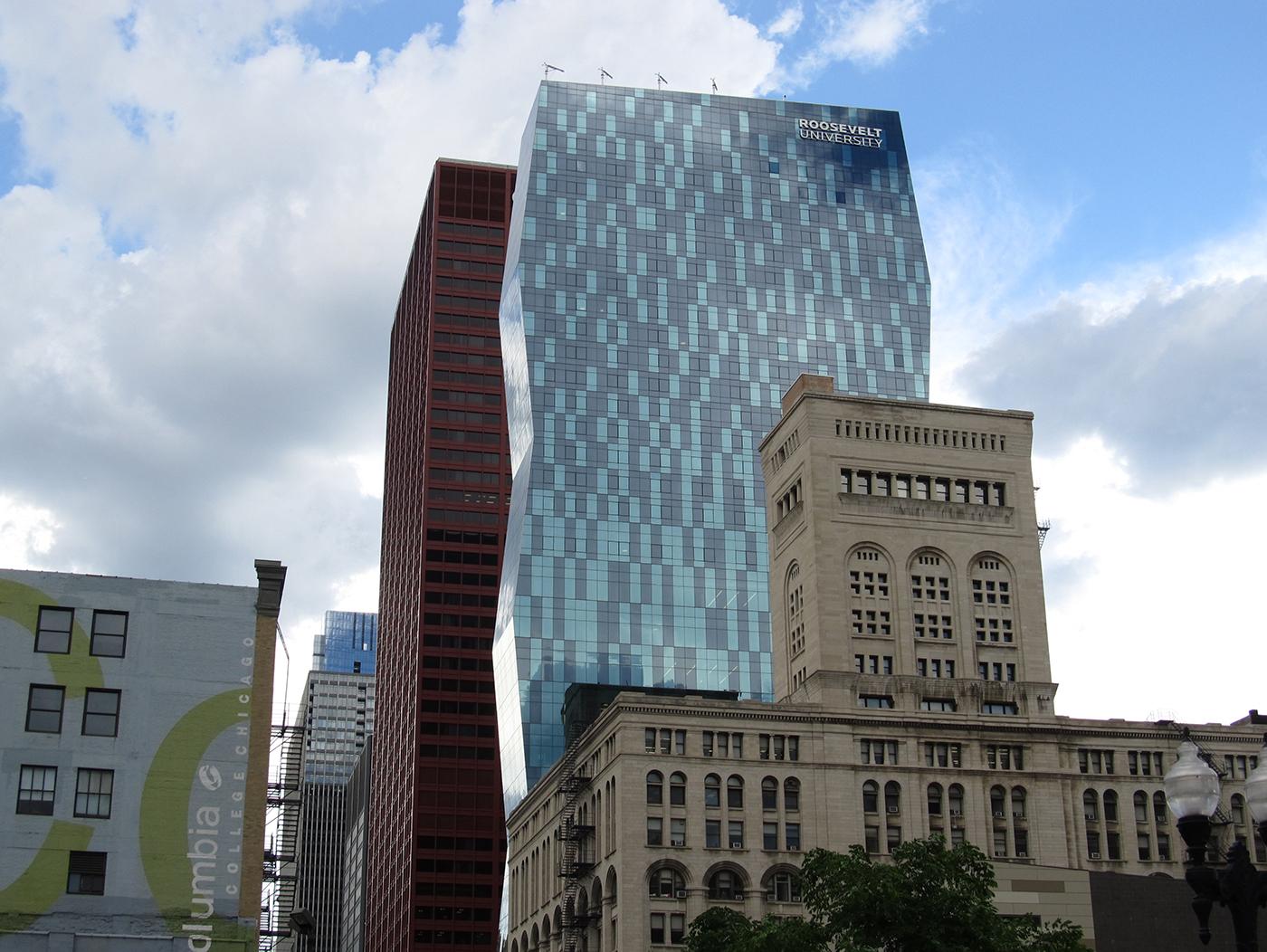 Roosevelt University's 2012 skyscraper connects to the Auditorium Building in front of it, which the University has owned since 1946. Photo: Ken Lund via Flickr
Roosevelt University's 2012 skyscraper connects to the Auditorium Building in front of it, which the University has owned since 1946. Photo: Ken Lund via Flickr
Roosevelt is another downtown campus that includes both historic and modern buildings. The University’s blue, polygonal 2012 skyscraper on Wabash Avenue designed by VOA Associates in 2012 connects to the Auditorium Building from 1889, a pioneering building by Louis Sullivan, arguably the father of the modern skyscraper, and his brilliant partner Dankmar Adler. Roosevelt has owned the Auditorium since 1946.
University of Illinois Chicago
 Walter Netsch's buildings for the University of Illinois Chicago are unforgivingly Brutalist and have been updated over the years. Photo: Artistmac via Wikimedia Commons
Walter Netsch's buildings for the University of Illinois Chicago are unforgivingly Brutalist and have been updated over the years. Photo: Artistmac via Wikimedia Commons
Some people might call this Near West Side campus a failed but fascinating architectural experiment in mid-century modernism. Little Italy and parts of nearby neighborhoods controversially designated for urban renewal were razed in the early 1960s for the construction of the campus, which had a master plan designed by Walter Netsch of the venerable Skidmore, Owings & Merrill. Netsch’s buildings were unforgivingly Brutalist, with exposed concrete and brown-tinted glass, but have been reimagined in recent decades to make them more functional, appealing, and energy efficient. Another expansion of the campus, begun in 2002, demolished the popular Maxwell Street Market. The campus is “one of Chicago’s strongest individual architectural statements—and one of the most violently disliked,” in the words of the AIA Guide to Chicago.
Rush University
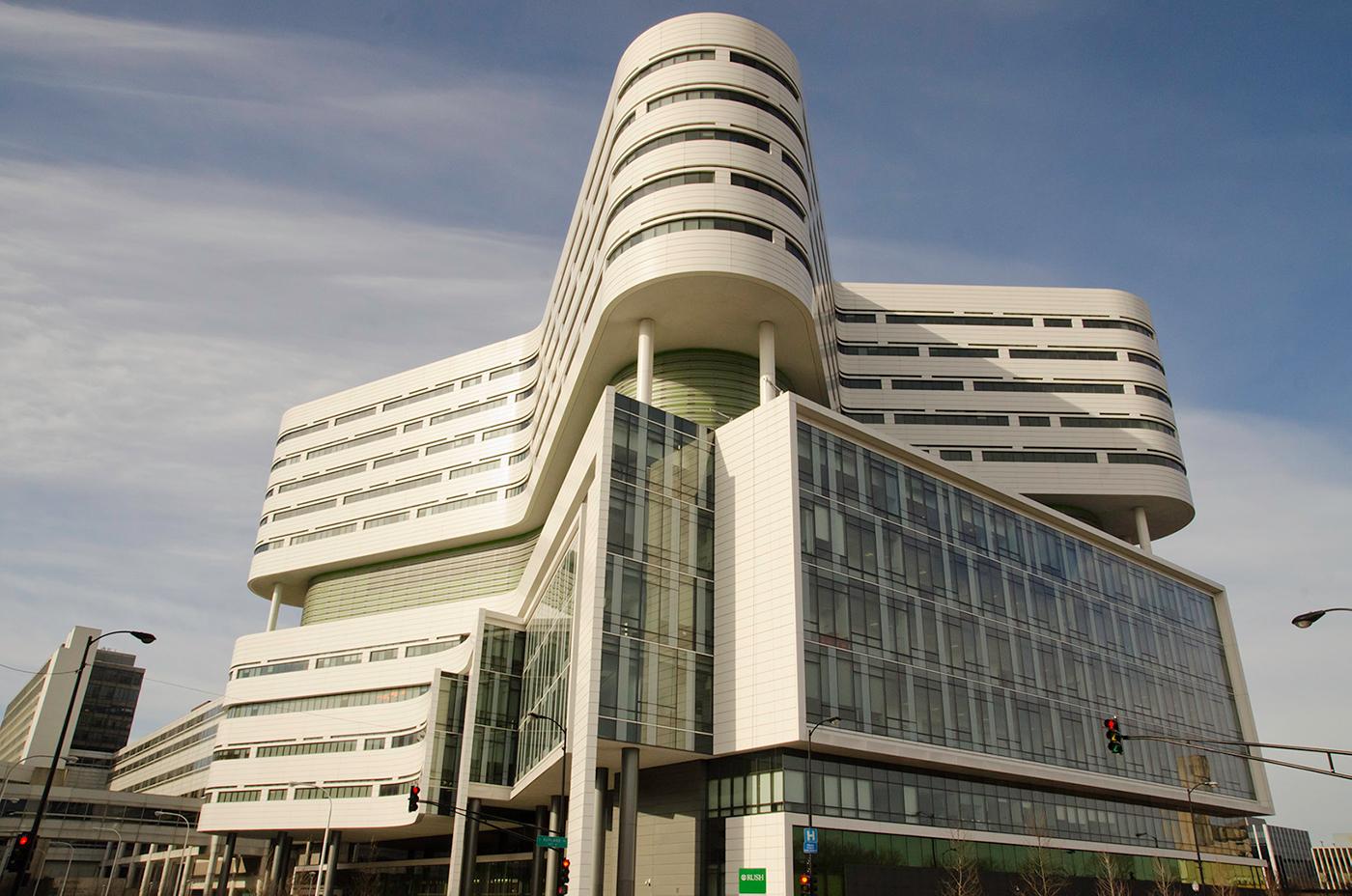 Rush University's Medical Center Tower is impossible to miss from the Eisenhower expressway. Photo: Nathan Hicks via Wikimedia Commons
Rush University's Medical Center Tower is impossible to miss from the Eisenhower expressway. Photo: Nathan Hicks via Wikimedia Commons
The University of Illinois Chicago’s college of medicine is located further west, in the Illinois Medical District that also houses Rush University’s Medical Center Tower, which is impossible to miss from the Eisenhower expressway. This 2012 Perkins & Will building’s four-pointed star shape is designed to improve efficiency in the hospital. It looks like a space station (albeit a beautiful, gleaming one, in my humble opinion).
Northeastern Illinois University
 The glass walls of El Centro follow a swooping curve in the Kennedy Expressway. Photo: Courtesy JGMA
The glass walls of El Centro follow a swooping curve in the Kennedy Expressway. Photo: Courtesy JGMA
NEIU’s El Centro campus in Avondale was designed by Juan Gabriel Moreno, and is as eye-grabbing from the Kennedy expressway as Rush’s Medical Center Tower is from the Ike. The glass walls follow a swooping curve in the expressway and are lined with fins in the school colors of blue and yellow. The building is featured in The Most Beautiful Places in Chicago, as is Moreno, who also designed Daley College’s vibrant Manufacturing, Technology and Engineering Center.
Loyola University
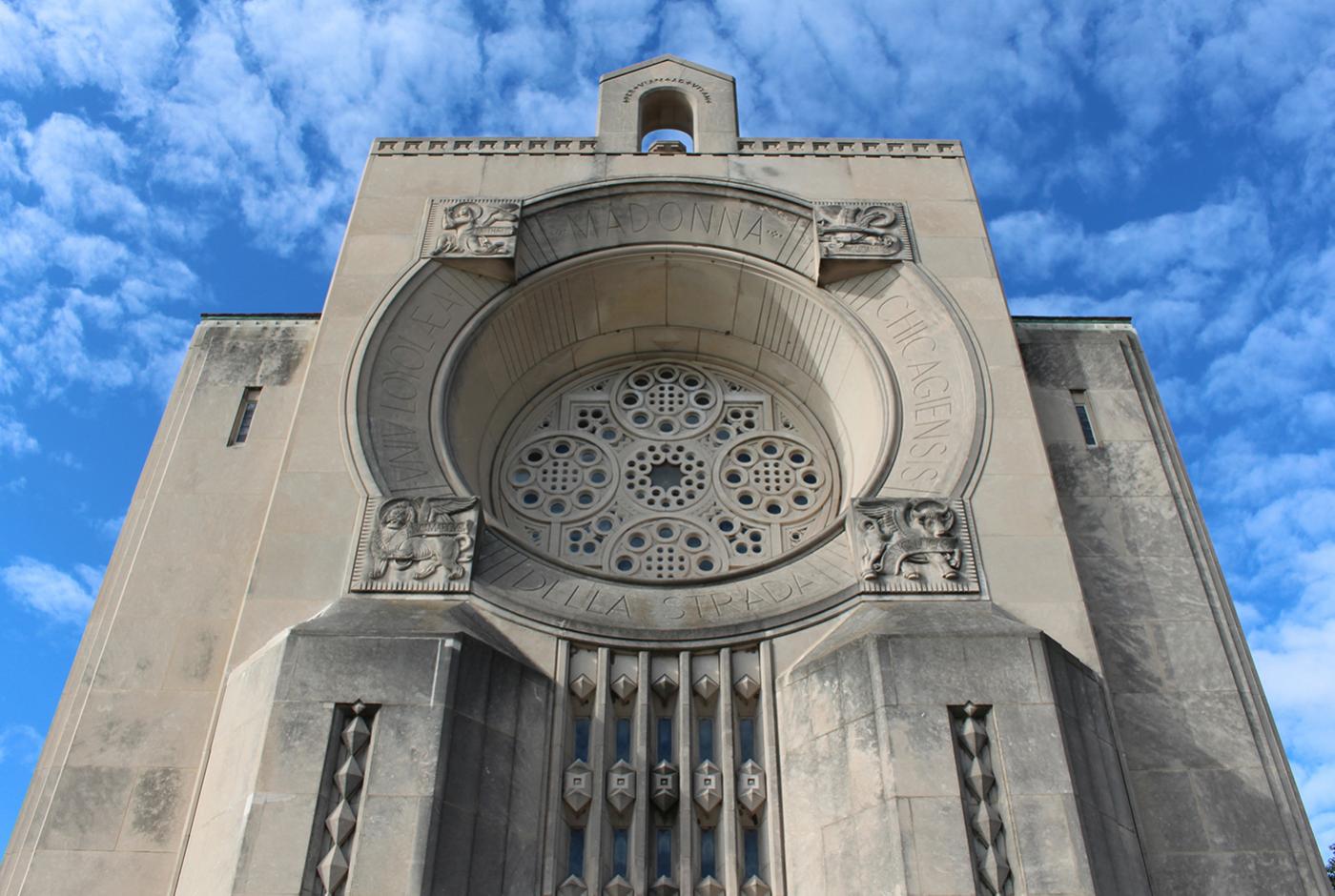 The Art Deco Madonna Della Strada Chapel looks modern while still obviously being a church. Photo: WTTW/Meredith Francis
The Art Deco Madonna Della Strada Chapel looks modern while still obviously being a church. Photo: WTTW/Meredith Francis
Loyola’s lakefront campus in Edgewater has two splendid Art Deco buildings. Andrew Rebori’s 1939 Madonna della Strada Chapel is a unique house of worship that looks modern while still obviously being a church. Its name roughly translates to “our lady of the highway,” because it was assumed that Lake Shore Drive would one day be extended past the church. The road never was, so the chapel’s front entrance faces Lake Michigan instead.
Mundelein Center is a college in a skyscraper from 1930, built for the women’s Mundelein College, which was absorbed by Loyola in 1991. Its entrance is guarded by two amazing Art Deco sculptures depicting the archangels Uriel and Jophiel.
Northwestern University
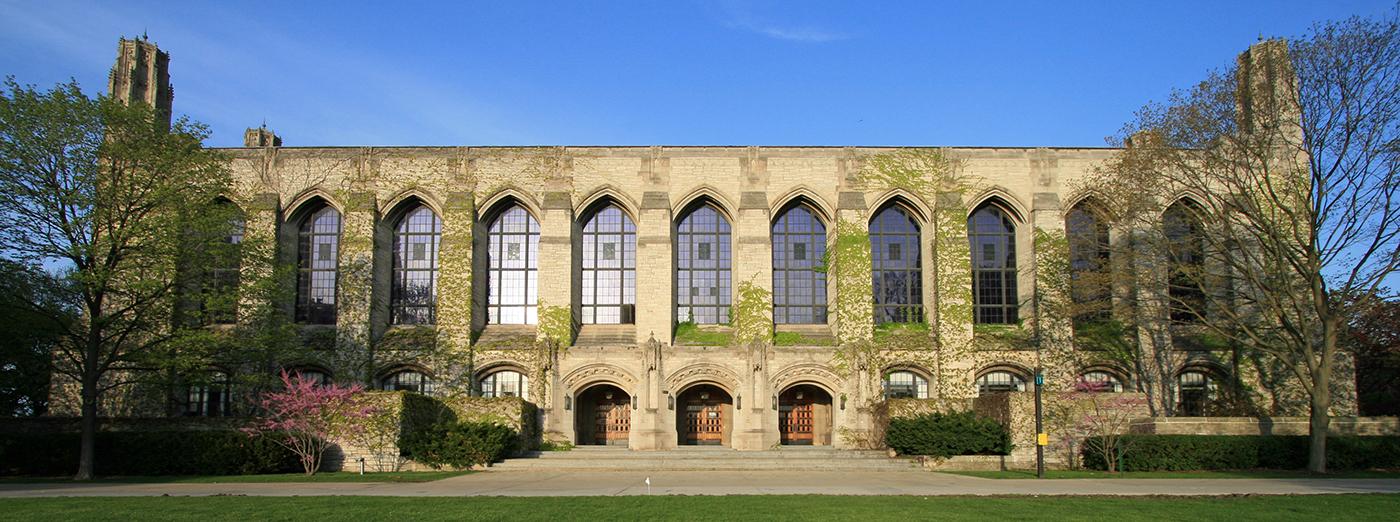 The Charles Deering Memorial Library was modeled after Cambridge's King's College Chapel. Photo: Madcoverboy via Wikimedia Commons
The Charles Deering Memorial Library was modeled after Cambridge's King's College Chapel. Photo: Madcoverboy via Wikimedia Commons
Like the University of Chicago, Northwestern is home to both thoroughly modern edifices and late-nineteenth century buildings in stereotypically academic styles. The Charles Deering Memorial Library was modeled after Cambridge’s King’s College Chapel but was replaced as the main library by a Brutalist Walter Netsch design that bears some resemblance to Netsch’s Joseph Regenstein Library at the University of Chicago. Annie May Swift Hall, from 1895, mixes several historic styles; the nearby Ryan Center for the Musical Arts by Chicago-based Goettsch Partners from 2015 is an energetic assemblage of angled glass boxes situated like a cruise ship right on Lake Michigan. The back wall of the stage in the recital hall is glass, with a spectacular view of the Chicago skyline in the distance.

